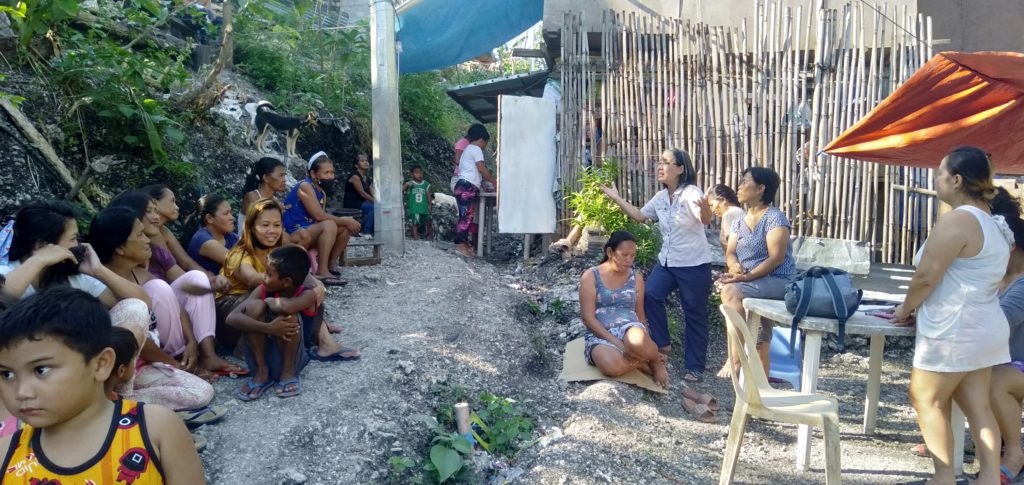A meeting was conducted with the project team and hospital staff of the Cebu Provincial Hospital – Bogo City regarding the hospital’s referral system last November 23, 2020
The meeting was attended by Chief of Hospital Dr. Zoraida G. Yurango and Chief Nurse Nilda D. Aranas, as well as five project staff members.
Dr. Erlinda Posadas presided over the meeting and started by introducing briefly about the USAID Project on COVID-19 response and that one activity is a meeting with local government units (LGU) and health facilities officials of the four project sites regarding the referral protocols for patients. The purpose of the present meeting was to know the referral system of patients from the four project sites to the hospital and from the hospital to other higher level hospitals.
Dr. Yurango said that their referral system is very functioning, and is responsive to the needs of the community and provides the appropriate health services matched and linked to the right health facility.
Dr. Yurango said that her hospital accepts patients from the three interlocal health zones or service delivery network, or health service provider network, namely: Bogo City, San Remigio, Medellin, Daanbantayan which comprise one network, Bantayan, Santa Fe, and Madridejos, which comprise another network, and Tabogon, Tabogon and Tuburan which comprise the third network.
The doctor who first sees the patient will have a thorough assessment of the patient, taking his history and physical examination and tests, if available, and decides if there is a need to refer the patient to the next higher level health facility. If yes, he will communicate to that facility, prepares the transport, and writes a referral slip and other documents, if any, to be brought by the patient to that higher facility.
The referral slip contains the relevant information of the patient’s illness. The health personnel accompanying the patient will bring back the portion of the referral slip that is filled up by the receiving referral center back to the referring health center for documentation. All referrals are recorded in a logbook specifically for health referrals, both by the referring and receiving health facilities.
There is also an electronic referral system in place between the Cebu Provincial Hospital and higher level hospitals in Cebu including Cebu Provincial Hospital in Danao City, Eversley Childs Sanitaurium in Mandaue City, Vicente Sotto Memorial Medical Center (VSMMC) in Cebu City, and Balamban Provincial Hospital in Balamban. The referring doctor will call the receiving doctor and also encode the information about the patient in the electronic referral system computer system which will be read by the receiving doctor. In this way, when the patient arrives in the receiving hospital, he will be attended to right away. The e-referral system has already been in place and functioning since 2015.
For instance, the MHO in Medellin, Dr. Oliver Gimenez, sees a patient who has a stroke, evaluates the patient and decides to refer him to the Cebu Provincial Hospital in Bogo City, or the VSMMC, writes the referral slip, lets his health personnel accompany the patient in an ambulance. He calls the resident doctor on duty in the hospital in Bogo City or VSMMC about the case.
Dr. Yurangco mentioned that the common cases that they accept from the rural health units are large wounds that need to be sutured in an operating room, appendicitis, stroke which has no need of CT scan or brain surgery, cesarian sections, and patients with hypertension or heart problems that they can manage with their facilities.
Patients that have to be referred to the higher level facilities include those with cancer that need laboratory tests, blood dyscracias, big tumors, endocrine diseases, brain problems, serious trauma cases that need surgery, abdominal cases that need surgery, and other serious illnesses that their facilities cannot handle.
The hospital also receives COVID-19 patients. For instance, they recently had a patient who was swabbed in the RHU in Medellin and isolated in their isolation facility but developed difficulty in breathing so he was referred to the Bogo City Hospital, where he was treated. COVID-19 patients who also have co-morbidities are accepted from the rural health units.
The hospital has an actual bed capacity of 50 beds but their patients can run up to 100 in a day.



